You guys rock! I've been coming here for weeks identifying the birds in our backyard for my daughter's school project. Thanks so much for this valuable resource.
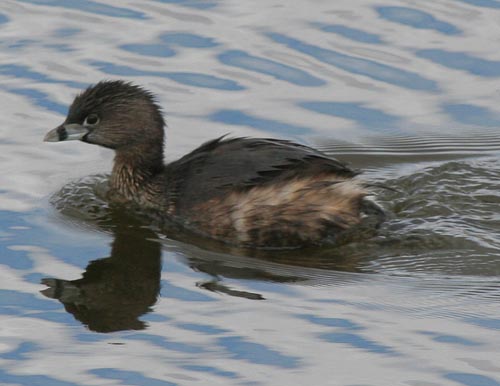
small duck-like bird found on rivers and lakes. Dives for fish. Notice the stout bill.
The Pied-billed Grebe, (Podilymbus podiceps)[1], is a member of the grebe family of water birds. Since the Atitlán Grebe, Podilymbus gigas, has become extinct, it is the sole extant member of the genus Podilymbus.
The Pied-billed Grebe breeds across Canada, parts of the United States, and temperate South America. Although this species does not appear to be a strong flier, it has occurred in Europe as a rare vagrant on a number of occasions, and one bird in England bred with a Little Grebe, producing hybrid young.
The most widespread of North American grebes, it is found on remote ponds, marshes, and sluggish streams. It is usually the first grebe to arrive on northern inland waters in springtime, and the last to leave in autumn. It is rare on salt water. This grebe rarely flies, preferring to escape danger by diving.
It feeds on fish (carp, catfish, eels), insects (dragonflies, ants, beetles), and amphibians (frogs, tadpoles).
Folk names of this grebe include dabchick, devil-diver, dive-dapper, hell-diver, and water witch
Photo © Sean Cronin
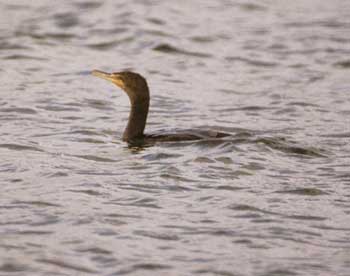
dark black bird with long neck. Dives for fish. Sometimes in large flocks where it will roost in trees by lakes.
The Double-crested Cormorant is a large black bird 74–91 cm (29"–36") long, with a wingspan up to 132 cm (52"). It has a long tail and a yellow throat-patch, and can appear to have a green sheen in certain lighting. The white double head crest is seen for a short period during the breeding season in western birds; it is duller in eastern birds. Juveniles are brown with a white face, foreneck, and breast.
A very common and widespread species, it winters anywhere that is ice-free along both coasts, as far north as southern Alaska (on the west coast) and southern New England (on the east coast). It can be found as far south as Mexico and the Bahamas. It migrates from the coldest parts of its breeding range, such as eastern Canada, and has occurred in Europe as a very rare vagrant, for example in Great Britain, Ireland and the Azores.
Photo © Marcus Lawson
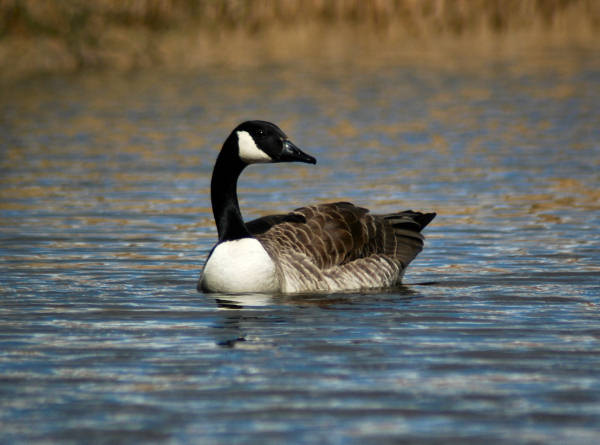
The black head and neck with white "chinstrap" distinguish this goose from all except the Barnacle Goose, but the latter has a black breast and grey, rather than brownish, body plumage. There are 7 subspecies of this bird, of varying sizes and plumage details, but all are recognizable as Canada Geese. Some are hard to distinguish from the Cackling Goose (Branta hutchinsii), with which the Canada Goose was long assumed to form one species, and the name Lesser Canada Goose is, confusingly, often applied to B. hutchinsii.
This species is 90-100 cm long with a 160-175 cm wing span. Males weigh 3.5–6.5 kg, (8–14 pounds ), and can be very aggressive in defending territory. A pair may mate for life (around 20 years). The female looks virtually identical but is slightly lighter at 3–5.5 kg (7–12 pounds), and has a different honk.
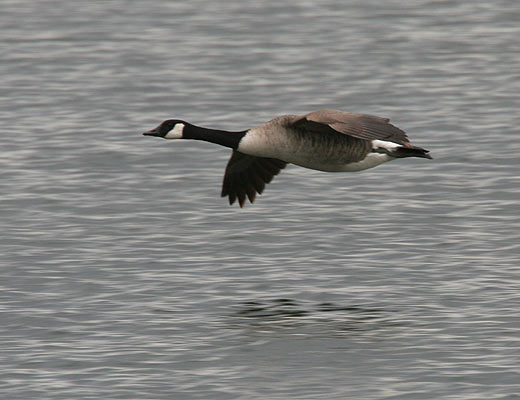
Photo © Steve Robinson
Photo © Matthew Berriman
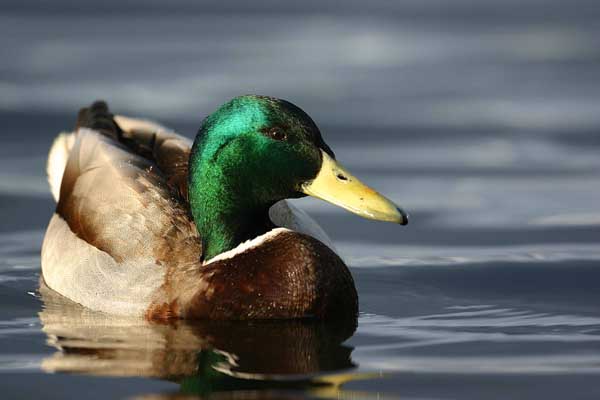
Very common duck. Males have green heads and females are brown and streaked.
This dabbling duck is 56-65 cm length, with an 81–98 cm wingspan, and weighs 750–1000 g. It is strongly migratory in the northern parts of its breeding range, and winters farther south. It is highly gregarious outside of the breeding season and will form large flocks. They are exceptionally fast flyers for their size, reaching speeds of 40mph. Due to their streamlining however, it hardly ruffles a feather.
The breeding male is unmistakable, with a green head, black rear end and a blue speculum edged with white, obvious in flight or at rest. Males also possess a yellow bill with a black tip, whereas females have a dark brown bill.
The females are light brown, with plumage much like most female dabbling ducks. They can be distinguished from other ducks, by the distinctive speculum. In non-breeding (eclipse) plumage, the drake looks more like the female.
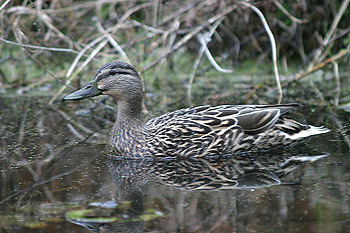
It is a bird of most wetlands, including parks, small ponds and rivers, and usually feeds by dabbling for plant food or grazing. It nests usually on a river bank, but not always particularly near water.
This is a noisy species. The male has a nasal call, whereas the female has the very familiar "quack" always associated with ducks.
Mallards frequently interbreed with the American Black Duck, Northern Pintail and domesticated species, leading to various hybrids. A Mallard has been recorded as living for 29 years.
Photo © Lee Davis
Photo © Jon Hall
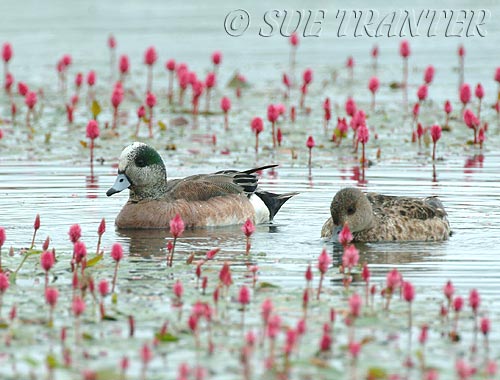
The American Wigeon (sometimes spelled Widgeon) or Baldpate (Anas americana) is a common and widespread duck which breeds in the northernmost areas of North America: in Canada in Saskatchewan, British Columbia, Alberta, Manitoba, Alaska, and the Northwest Territories and the Great Lakes. It is the New World counterpart of the European Wigeon.
This dabbling duck is strongly migratory and winters further south than its breeding range as south as in Texas and Louisiana coast of the Gulf of Mexico. It is a rare but regular vagrant to western Europe. It is highly gregarious outside of the breeding season and will form large flocks.
The breeding male has pinkish flanks and breast back, with a black rear end and a brilliant white speculum, obvious in flight or at rest. It has a greyish head with a green eye patch and a whitish crown stripe. It is 18-23" long.
The females are light brown, with plumage much like a female Mallard. They can be distinguished from most ducks, apart from European Wigeon on shape. However, that species has a darker head and all grey underwing.
In non-breeding (eclipse) plumage, the drake looks more like the female.
It is a bird of open wetlands, such as wet grassland or marshes with some taller vegetation, and usually feeds by dabbling for plant food or grazing, which it does very readily. It nests on the ground, near water and under cover. It lays 6-12 creamy white eggs.
This is a noisy species. The male has a clear whistle in three syllables: whoee-whoe-whoe, whereas the female has a low growl qua-ack.
Photo © Sue and Andy Tranter
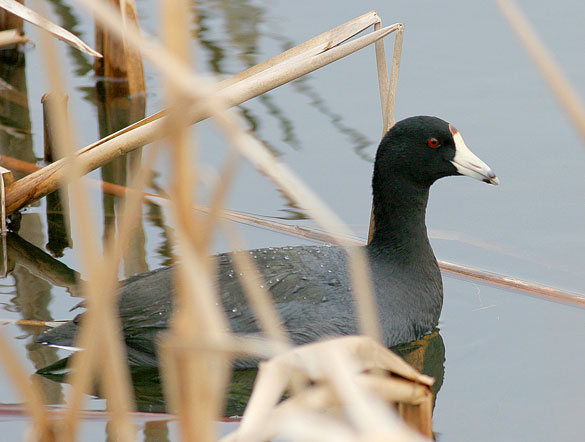
Adults have a short thick white bill and white frontal shield, with a reddish-brown spot near the base of the bill between the eyes. The body is grey with the head and neck darker than the rest of the body. Their legs are yellowish, with scalloped toes rather than webbed feet. Their chicks have black bodies with bright red head and beak, and orange plumes around the neck.
Their breeding habitat is marshes from southern Quebec to the Pacific coast of North America and as far south as northern South America. They nest in a well-concealed location in tall reeds. They are frequently seen swimming in open water.
They migrate from northern locations to the southern United States and southern British Columbia. They are often year-round residents where water remains open in winter.
These birds can dive for food but can also forage on land. They are omnivores, eating plant material, insects, fish, and other aquatic animals. Adults mostly consume "pond scum".
Their call is a high-pitched squeaking honk somewhat like a goose's but more hollow sounding.
American coots are highly territorial during the breeding season, with both males and females fighting with neighbors to maintain a small territory where they obtain all their food. The females are known to lay eggs in neighbors' nests (known as conspecific brood parasitism).
Photo © Mark S. Szantyr

The Common Moorhen (Gallinula chloropus) is a bird in the rail family with an almost worldwide distribution outside Antarctica and Australasia. In North America it was previously called the Common Gallinule.
This is a common breeding bird in marshy environments and well-vegetated lakes. It is often secretive, but can become tame in some areas. Populations in areas where the waters freeze, such as southern Canada, the northern USA and eastern Europe, will migrate to more temperate climes.
This is a distinctive species, with dark plumage apart from the white undertail, yellow legs and a red facial shield. The young are browner and lack the red shield. It has a wide range of gargling calls.
This species will consume a wide variety of vegetable material and small aquatic creatures. They forage while swimming, sometimes upending to feed, or walking through the marsh.
The nest is a roofed basket built on the ground in dense vegetation. 4-8 eggs are laid, which are incubated for about three weeks. Both parents incubate and feed the young. More than one brood may be raised in a year.
Despite loss of habitat in parts of its range, this bird remains common and widespread.
Photo © Neil Loverock
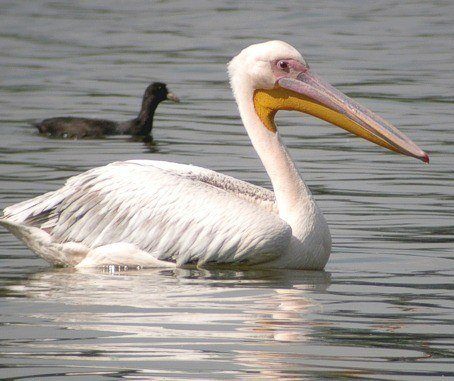
The American White Pelican (Pelecanus erythrorhynchos) is a very large (50"–70") white bird with black wing tips and an enormous orange bill. They have a wing span of approximately 3 m . They are graceful in flight, moving their wings in slow powerful strokes.
Unlike the Brown Pelican, the American White Pelican does not dive for its food. Instead it practices cooperative fishing. Each bird eats more than 4 pounds of fish a day, mostly carp, chubs, shiners, yellow perch, catfish, and jackfish.
White Pelicans nest in colonies of several hundred pairs on islands in remote brackish and freshwater lakes of inland North America. The female lays 2 or 3 eggs in a shallow depression on the ground. Both parents incubate.
They winter in central California and along the Pacific coast of Guatemala; also along the shores of the Gulf of Mexico.
Shooting by poachers is the largest known cause of mortality. Colonies are sensitive to disturbance and visits by humans can cause the pelicans to leave and abandon their nests.
This species is protected by the Migratory Bird Treaty of 1972.
The scientific name for this species combines Pelecanus, the Latin for pelican, with erythrorhynchos, derived from the Greek words erythros meaning red, and rhynchos meaning beak.
Photo © Pete Morris/Birdquest
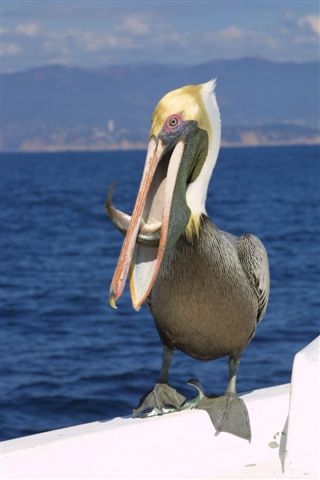
The Brown Pelican (Pelecanus occidentalis †) is the smallest (42"-54") member of the seven species of the pelican family.
It lives strictly on coasts from Washington and Cape Cod to the mouth of the Amazon River. Some immature birds may stray to inland freshwater lakes. After nesting, North American birds move further north along the coasts in flocks, returning to warmer waters for winter.
This bird is distinguished from the American White Pelican by its brown body and its habit of diving for fish from the air, as opposed to co-operative fishing from the surface. It dines mostly on herring-like fish. Groups of these birds often travel in single file, flying low over the water's surface.
The nest location varies from a simple scrape on the ground on an island to a bulky stick nest in a low tree. These birds nest in colonies, usually on islands.
Pesticides like DDT and dieldrin threatened its future in the southeast United States and California in the early 1970s. Pesticides also threatened the pelican population in Florida in this time period. A research group from the University of Tampa headed up by Dr. Ralph Schreiber conducted research in the Tampa Bay/St Petersburg area and found that DDT caused the pelican eggshells to be overly-thin and incapable of supporting the embryo to maturity. As a result of this research, DDT usage was eliminated in Florida and the rest of the country.
It is the state bird of Louisiana.
Photo © Terry Lunn